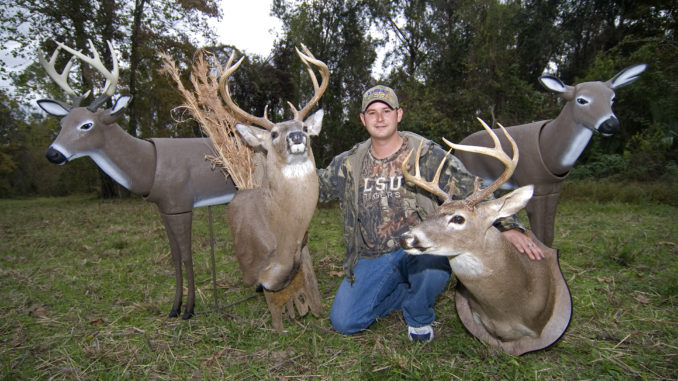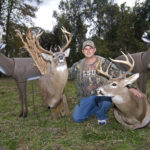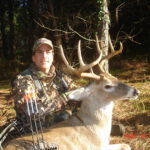
How many times have you seen a buck lurking in the thickets, but been unable to get a shot? Here’s a great way to pull those wary animals out of the brush.
Brad Pourciau had caught glimpses of a buck from a pipeline stand, but never could get a clear shot. The Baton Rouge hunter was lamenting that fact back at the camp, and one of his buddies told him there was a sure-fire way of bagging that deer. “He said, ‘I know how to get him to come out,’” Pourciau said. “He told me he’d let me use his decoys.”
So the two men trudged out to the pipeline just after lunch, and set up a foam buck and a doe decoy, and Pourciau climbed into his stand.
He wasn’t sure about the whole deal, though.
“I thought my hunt was over,” he admitted. “I mean, we got out there about 1 p.m.”
However, he then made a series of grunts, and was shocked at what happened next.
“I still had the grunt call in my mouth, and I saw a buck sticking its head out (of the woods),” Pourciau said.
The rack buck saw the decoys, and stepped out only 30 yards from the fake deer.
Pourciau said there was no worry that moving to get into shooting position would be a problem.
“His main attention was focused on that decoy,” he said of the approaching deer.
The buck eased up to the buck decoy, stretched out its neck and gave it a sniff.
“As soon as he smelled it, he jumped back and gave me a broad-side shot,” Pourciau said. “I put the crosshairs on the deer, and shot it.”
The following weekend, the Baton Rouge hunter returned to the same stand, placed the decoys and killed a smaller-racked 9-point.
That sealed the deal: Pourciau was a true believer.
“Decoys draw attention away from you,” he said. “When that deer comes out, he’s looking at the decoys and not at you.”
Pourciau said the key to success with decoys is visibility: Deer must be able to see the decoys. That means they are most effective when used in open habitat, such as fields or pipelines.
The first benefit is that decoys can make deer more likely to step out into the open if other deer are present.
“Deer are more comfortable when they have cover, but if they see other deer in a field they’ll come out,” Pourciau said. “How many times do you see a deer in brush and can’t get a shot?
“I firmly believe that most of the time bucks see you and you don’t see them.”
He said that’s because deer aren’t stupid.
“They know where your stand is,” Pourciau said. “I think they usually see you before you can see them.”
Decoys also provide something to distract their attention away from your stand and, when they do step out, increase the chances of getting a kill shot.
“Normally, when a mature buck crosses a pipeline, he’s moving pretty quickly,” Pourciau said. “How many times does that happen and you don’t get a shot?
“When he comes out and sees decoys, he’ll stop.”
Even if the deer doesn’t respond otherwise and investigate the decoys, the pause provides ample time to get a shot off.
Of course, Pourciau said there’s little use in setting up decoys unless bucks are present. After all, the decoy doesn’t draw in bucks — it simply provides hunters with shots at deer as they pass.
“You have to get in an area you know there’s a buck,” Pourciau said. “When I find a place with good buck sign, I get out (of the area) right away; I leave out the same way I came in so I don’t leave any more scent than necessary.”
He then stays away from the area until he’s got time to hunt it.
And that introduces one of the only real problems with decoys: It takes extra time to set them up.
“I’ll get in my stand an hour before daylight to make sure to get the decoys set up,” he explained.
Pourciau hurriedly sets up the decoys, making sure that the forms aren’t too close to his stand position.
“The farther away (from your stand) the better,” he said.
It’s then a matter of fate whether or not the buck shows up.




